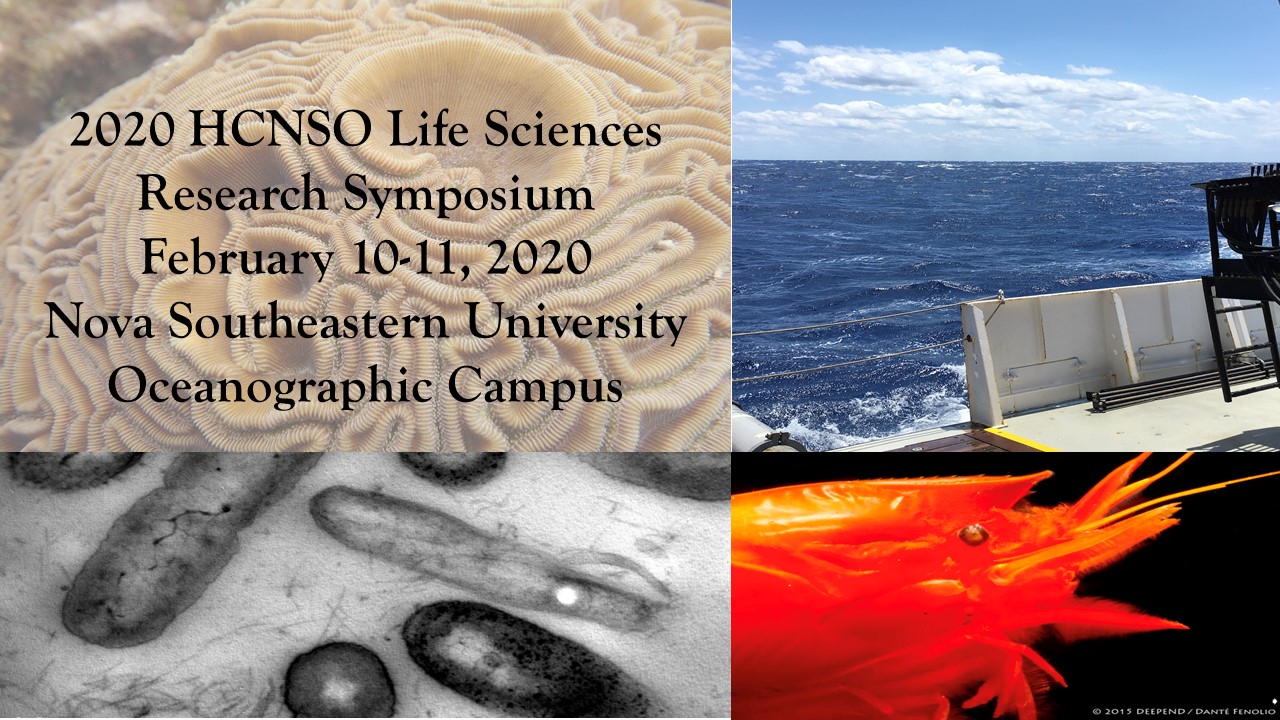Title
Annotation of the Metagenome of the Common Caribbean Sponge Genus Cinachyrella to characterize its Dominant Microbial Symbionts
Location
HCNSO Guy Harvey Oceanographic Center Nova Southeastern University
Start
2-11-2020 9:45 AM
End
2-11-2020 10:00 AM
Type of Presentation
Oral Presentation
Abstract
Host associated microbes play important, sometimes vital roles in animal health. The symbiotic relationship between sponges and their resident microorganisms, in particular prokaryotes, forms a complex mutualistic system. The prokaryotes can provide many possible nutritional sources for the host sponge. However, the whole metabolism of a sponge holobioint and the respective contributions of their symbionts and their associations with the host remain unclear.
Metagenomics is a molecular approach to study communities by analyzing the gene content of the microorganisms for both taxonomic affiliation and function after high throughput DNA sequencing without culturing. The microbiome refers to the complete set of genes within the microbes that occupy their host. The primary objective of this study was to describe the dominant microbiome diversity, composition, and the most abundant microbial gene families within the local reef sponge Cinachyrella sp. Secondly, I have determined the differences between the twenty-seven metagenomes in side by side bioinformatics comparisons of the metagenome sequences to find the functional roles in the microbial-sponge symbiosis. Sponge metagenome sequences were assembled and taxonomically binned. Twenty-seven most abundant and reliable Metagenomically Assembled Genomes (MAGs) were taxonomically classified and functionally assigned. Several bacterial MAGs possess genes with predicted functions in quorum sensing and sulfur metabolism. Twenty-one out of twenty-seven MAGs expressed 3'-phosphoadenosine 5'-phosphosulfate synthase (PAPSS), which is the universal sulfonate donor’s synthase. This finding reflects that the microbiome has sulfur requirements. Moreover, I found that fifteen of the MAGs express a cysJ gene, which is responsible for catalyzing the 6-electron reduction of sulfite to sulfide, which is a part of the detoxification system. Therefore, this finding suggests that this metagenome has an active detoxification system for the removal of toxic and mutagenic nucleobases. Moreover, this research reconstructed the whole functional map by calculating the number of genes belonging to all possible prokaryotic Kyoto Encyclopedia of Genes and Genomes (KEGG) functions.
Annotation of the Metagenome of the Common Caribbean Sponge Genus Cinachyrella to characterize its Dominant Microbial Symbionts
HCNSO Guy Harvey Oceanographic Center Nova Southeastern University
Host associated microbes play important, sometimes vital roles in animal health. The symbiotic relationship between sponges and their resident microorganisms, in particular prokaryotes, forms a complex mutualistic system. The prokaryotes can provide many possible nutritional sources for the host sponge. However, the whole metabolism of a sponge holobioint and the respective contributions of their symbionts and their associations with the host remain unclear.
Metagenomics is a molecular approach to study communities by analyzing the gene content of the microorganisms for both taxonomic affiliation and function after high throughput DNA sequencing without culturing. The microbiome refers to the complete set of genes within the microbes that occupy their host. The primary objective of this study was to describe the dominant microbiome diversity, composition, and the most abundant microbial gene families within the local reef sponge Cinachyrella sp. Secondly, I have determined the differences between the twenty-seven metagenomes in side by side bioinformatics comparisons of the metagenome sequences to find the functional roles in the microbial-sponge symbiosis. Sponge metagenome sequences were assembled and taxonomically binned. Twenty-seven most abundant and reliable Metagenomically Assembled Genomes (MAGs) were taxonomically classified and functionally assigned. Several bacterial MAGs possess genes with predicted functions in quorum sensing and sulfur metabolism. Twenty-one out of twenty-seven MAGs expressed 3'-phosphoadenosine 5'-phosphosulfate synthase (PAPSS), which is the universal sulfonate donor’s synthase. This finding reflects that the microbiome has sulfur requirements. Moreover, I found that fifteen of the MAGs express a cysJ gene, which is responsible for catalyzing the 6-electron reduction of sulfite to sulfide, which is a part of the detoxification system. Therefore, this finding suggests that this metagenome has an active detoxification system for the removal of toxic and mutagenic nucleobases. Moreover, this research reconstructed the whole functional map by calculating the number of genes belonging to all possible prokaryotic Kyoto Encyclopedia of Genes and Genomes (KEGG) functions.


